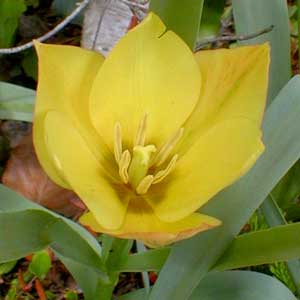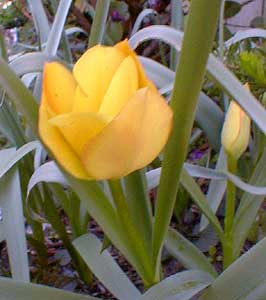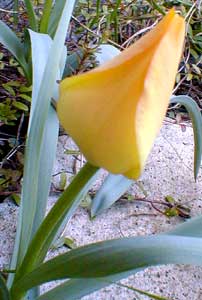 'Bright Gem'
'Bright Gem'
Batalin's Botanical Tulip
"She slept beneath a tree
Remembered but by me.
I touched her cradle mute;
She recognized the foot,
Put on her carmine suit, —
And see!"
-"The Tulip
by Emily Dickinson
by Emily Dickinson
Tulipa batalinii 'Bright Gem' is one of the smaller species tulips at only six to ten inches or occasionally a foot to tip of flower. The wild form, which is entirely yellow, was first described by Eduard August von Regal in 1889. Dr. Regel collected it in the Pamir & Alai mountains of Cental Asia.
The select strain 'Bright Gem' is apricot yellow with bronzy sheen on the outside, or sometimes with greenish sheen. They are yellowest when grown in colder zones, bronzier with a stronger greenish tinge in purely temperate climates.
 This native to Iran, Uzbekistan & Turkestan is named for the Russian botanist Alexander Feodorowicz Batalin (1847-1896), curator from 1870 until his death of the Imperical Botanical Garden at St. Petersburg. Dr. Batalin provided England's Kew Gardens with its first T. batalinii bulbs in 1888. It was introduced more widely to gardening by P. L. Grueber, a bulb hunter for the famed Dutch company of van Tubergen, the very source of the bulbs we planted.
This native to Iran, Uzbekistan & Turkestan is named for the Russian botanist Alexander Feodorowicz Batalin (1847-1896), curator from 1870 until his death of the Imperical Botanical Garden at St. Petersburg. Dr. Batalin provided England's Kew Gardens with its first T. batalinii bulbs in 1888. It was introduced more widely to gardening by P. L. Grueber, a bulb hunter for the famed Dutch company of van Tubergen, the very source of the bulbs we planted.Some have suspected the cultivar 'Bright Gem' is the same as 'Sunrise' which was honored by the Royal Horticultural Society with the Award of Garden Merit in 1901. 'Sunrise' was never registered & its specific history went unrecorded, but some hybrids appear to have originated in Ireland from Hogg & Robertson, whose uncertain cultivars were derived from crosses of T. batalinii with T. linofolia.
Others suppose that 'Bright Gem' like several other varieties originated through the hybrid program of W. R. Dykes, who pollinated T. batalinii with T. maximoviczii to obtain several new colors; Dykes in any case registered 'Bright Gem' in 1952.
 Before even considering the muddle presented by its cultivars, it has often been suggested that wild T. batalinii is not properly a distinct species, but is only a xanthic form of T. linifolia, & some would thus name it T. linifolia var batalinii. Martyn Rix likewise believed it might be only a color variant rather than a distinct species, but would assign it to T. maximoviczii.
Before even considering the muddle presented by its cultivars, it has often been suggested that wild T. batalinii is not properly a distinct species, but is only a xanthic form of T. linifolia, & some would thus name it T. linifolia var batalinii. Martyn Rix likewise believed it might be only a color variant rather than a distinct species, but would assign it to T. maximoviczii.Sir Daniel Hall was first to point out that T. linifolia, T. maximoviczii, T. clusiana & T. batalinii all cross-pollinate with one another, but will not do so with any other species, thus all four are very closely related.
Like all tulips it wants lots of sunlight in moist well draining soil throughout its growing season, drier during summer & winter dormancy. Gritty soil suits it best. We planted twenty bulbs at the base of a dwarf Alpine Fir, where it gets full morning sun & diffuse afternoon sun. Other short perennials with very differing primary seasons grow amidst these, including cyclamens that are active in winter when the tulips are gone.
Though it turns out to have been a sufficiently sunny spot, I had worried about it not getting quite a full six hours by the alpine fir. Some dwarf tulips such as T. bakeri 'Lilac Wonder' are fully open under any bright sky even without the sun being directly on them, but others, such as T. urumiensis & T. batalinii are only fully opened when the sun is directly on them.
So in their morning-sun location our 'Bright Gem' opens into a rather round-looking flattened cup for the first few sunny hours of the day (as shown in the first April photo), until the first hint of shadow falls on them, then they fold back up into eggs (as shown in the second photo), then by evening fold a bit tighter into curious three-sided pyramids that look almost like some sort of pointed oragami box (third photo) & remain in this pose until the sun hits them the next morning.
They look nice open, half-closed, or closed, so it's not a huge error that they get only morning sun, but if I'd been more aware of their behavior before I planted the bulbs, I'd've tried to find them a spot that gets direct shots of both morning & afternoon light. When the following autumn (2004) we got ten more bulbs, we placed those further out into the yard where they'd get a bit more sun, but still mainly well-sunned throughout the morning & much less so in the afternoon.
In autumn 2005 we added eight more 'Bright Gem' bulbs in a spot with full afternoon sun, mixed with the same-sized intensely red 'Red Hunter' tulip also of the batalinii group. 'Bright Gem' is simply a wonderful enough variety to have naturalizing in multiple locations.
'Bright Gem' has greyish green leaves, sometimes emerging with temporarily reddish edges. The flowers begin early to mid-April (but in some gardens might start by late March) are are very nicely offset by the grey-green foliage.
When bulbs are planted in Autumn, because they only need to be placed two (to six) inches under the soil, they're a good choice to layer above other bulbs that need to be six inches down, always baring in mind how small Batalini's tulips are so that anything they are planted with should also be somewhat miniature & not send up overshadowing leaves.
Spent flowers should be removed so that the energy goes into revitalizing bulbs & offshoots instead of seeds. As with other species tulips & bulbous plants generally, the leaves should not be cut back until they begin to yellow. This permits bulbs to recharge before going summer-dormant, so that they will thrive in the garden for many years.
See also:
Tulipa batalinii 'Red Gem'